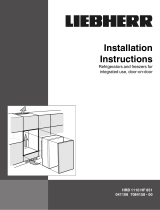
Contents
1 General safety information................................... 2
2 Transporting the appliance................................... 2
3 Installing the appliance......................................... 2
4 Appliance dimensions........................................... 3
5 Recess dimensions............................................... 3
6 Unit door................................................................. 4
7 Ventilation of the kitchen unit............................... 5
8 Changing over door hinges.................................. 5
9 Water connection*.................................................. 6
10 Installing the appliance in the recess.................. 6
11 Disposing of packaging........................................ 7
12 Connecting the appliance..................................... 7
Illustrated installation instructions...................... 8
The manufacturer works constantly on the further development
of all the types and models. Therefore please understand that
we have to reserve the right to make design, equipment and
technical modifications.
To get to know all the benefits of your new appliance, please
read the information contained in these instructions carefully.
The instructions apply to several models. Differences may
occur. Text relating only to specific appliances is marked with
an asterisk (*).
Instructions for action are marked with a , the results of
action are marked with a .
1 General safety information
-
Only install, connect and dispose of the appli-
ance according to the instructions.
-
The socket must be easily accessible so that
the appliance can be quickly disconnected
from the supply in an emergency. It must be
outside the area of the rear of the appliance.
DANGER identifies a situation involving direct
danger which, if not obviated, may
result in death or severe bodily
injury.
WARNING identifies a dangerous situation
which, if not obviated, may result in
death or severe bodily injury.
CAUTION identifies a dangerous situation
which, if not obviated, may result in
minor or medium bodily injury.
NOTICE identifies a dangerous situation
which, if not obviated, may result in
damage to property.
Note identifies useful information and tips.
2 Transporting the appliance
u
Transport the appliance only in suitable packaging.
u
Transport the appliance upright.
u
Do not transport the appliance on your own.
3 Installing the appliance
WARNING
Risk of fire due to short circuit!
If the mains cable/connector of the appliance or of another
appliance touch the rear of the appliance, the mains cable/
connector may be damaged by the appliance vibrations,
leading to a short circuit.
u
Stand the appliance so that it is not touched by connectors
or main cables.
u
Do not plug the appliance or any others into sockets located
near the rear of the appliance.
WARNING
Fire hazard due to dampness!
If live parts or the mains lead become damp this may cause
short circuits.
u
The appliance is designed for use in enclosed areas. Do not
operate the appliance outdoors or in areas where it is
exposed to splash water or damp conditions.
u
Only use the appliance when it is installed.
WARNING
Fire hazard due to refrigerant!
The coolant used is eco-friendly but also flammable. Any
leaking coolant may ignite.
u
Do not damage the piping of the refrigeration circuit.
WARNING
Fire hazard and danger of damage!
u
Do not place appliances emitting heat e.g. microwaves,
toasters etc. on the appliance!
Note
The bags at the rear of the appliance are important for proper
operation. Their contents are nontoxic and nonhazardous.*
u
Do not remove the bags!
NOTICE
Risk of damage due to condensation!*
When assembling an appliance name beginning with S... or
a side-by-side (SBS) appliance:
u
The appliance can be installed next to another refrigerator or
freezer.
If your appliance name does not begin with S...:
u
Do not install the appliance next to another refrigerator or
freezer.
NOTICE
Risk of damage due to condensation!*
When stacking multiple appliances there is a risk of conden-
sation damage.
Your (S)IG.. or (S)IB.. is equipped with overhead heating up to
a height of 880 mm.
u
Do not stack refrigerators or freezers unless the bottom
appliance is your IG.. or IB.. model up to a height of 880 mm.
WARNING
Blocked ventilation openings pose a risk of fire and damage!
u
Always keep the ventilation openings clear. Always ensure
that the appliance is properly ventilated!
General safety information
2 * Depending on model and options


















